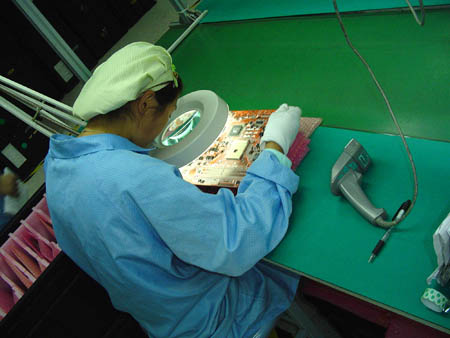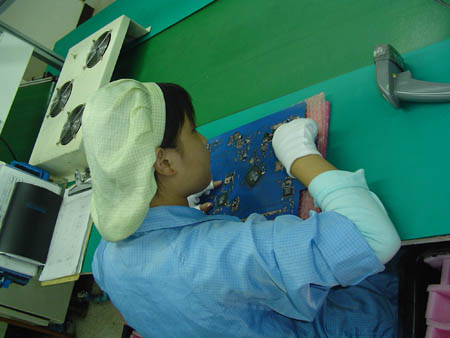The Birth of an Abit NF7 - A Factory Tour
by Kristopher Kubicki on June 11, 2004 10:12 PM EST- Posted in
- Motherboards
SMT QA
After the SMT process, we can see the transformation that the board has undergone. The north and south bridges are now present, along with thousands of ceramic capacitors and LEDs. This particular board is a K8V Pro, but we would see a very similar end result on the NF7. SMT lines run the same model and do not skip around; we shot this picture from a different line.Since SMT is the most complicated procedure when producing a motherboard, rigorous testing is done at this point. The boards must past visual inspection to assure no stray SMDs are printed, and then the boards are checked to make sure every SMD is lined up properly. A single offset capacitor can mean the difference between a working and non-working motherboard.
Because of the stringent quality control, the first visual inspection is done with an overlay to help a factory worker inspect the components. You can see this process below. The inspector in this image is looking specifically for misaligned components.
Manual visual inspection is starting to get too costly and inefficient for Abit's means. The important thing to consider about labor in China is that it is very cheap; manual labor is almost always preferred when possible. On some production lines, a $200,000 visual inspection machine replaces the job of two physical inspectors. The machine and a technician can do a more exhaustive examination of a motherboard at a slightly faster pace than 1 traditional visual inspector, but the cost benefit ratio is not very good. The machine technician and the traditional visual inspectors are paid about the same; usually around $100 per month with lodging.
Several attendees on the tour were surprised about the sheer amount of physical labor in a factory like Rolly. Rolly is actually quite small in comparison to some of the other factories that we have seen. It employs 1,400 workers and runs a single 8AM to 5PM shift. Even if it takes 10 workers to do the job of a single $200,000 machine, the cost of the machine usually outweighs the cost of using manual labor. Futuristic, all machine-run factories don't exist in China.
One thing that caught our attention at the Abit factory was the process of quality control. We recall the Elite Group factory tour from a year ago; when workers detected component failure or issues with a board after SMT, the board was completely pitched. At Rolly, we noticed that if a motherboard failed, it was immediately retested. Occasionally, these boards would fail continually, but after several tries, the components would usually pass inspection. Abit representatives explained to us that this procedure was because Rolly purposely sets inspection tolerances too tight and compensates for the extra manpower to test and retest (and retest again) by relying on its relatively cheap workforce.












19 Comments
View All Comments
KristopherKubicki - Sunday, June 13, 2004 - link
Got it, thanks.Kristopher
kalaap - Sunday, June 13, 2004 - link
"This is actually the second over on the production line; the first is used right after SMT."I think you meant second OVEN.
AtaStrumf - Sunday, June 13, 2004 - link
Right Click --> Save Target As... ---> save to disk and play from there. If its still not working you need a new player. Real One Player is preety good.roostercrows - Sunday, June 13, 2004 - link
can someone tell me which video players you guys use? i couldn't get my realplayer to download the videos. thanksDonB - Sunday, June 13, 2004 - link
"...why there are more women than men". Women have much better manual dexterity than men. Remember typing classes in high school? I remember in my class, after the first semester, the females were typing around 40-50 wpm while the males were typing around 25-35 wpm, almost without exception.CurtOien - Sunday, June 13, 2004 - link
"The machine technician and the traditional visual inspectors are paid about the same; usually around $100 per month with lodging."I wonder how much the executives make?
AtaStrumf - Sunday, June 13, 2004 - link
The problem that I see with their testing procedure is that they probably only test at default settings, which is just not good enough for an enthusiast targeted motherboard. Sure my KT7 A worked fine at 100 MHz FSB, but it didn't at 133 MHz FSB, and my latest AN7 works fine at default BIOS setting, but when you change something strange things start to happen.I understand that they're in a hurry, but they should at least test at the most stressful settings that the mobo is supposed to function properly i.e. 200 MHz FSB and not 133 or. 166 MHz. What good is a 24 h burn-in test if it's done at 133 MHz FSB, and I'm gonna be using a 200 MHz FSB.
For instance this AN7 that I have now, works perfectly if I OC my 2500+ with the default offered 3200+, but if I change the FSB manualy to 200 its totaly unstable. How strange is that?
KristopherKubicki - Sunday, June 13, 2004 - link
artifex: I have not heard that reason for using women over men in facilities.What other economic information were you interested in? I can add it to the article.
Kristopher
artifex - Sunday, June 13, 2004 - link
I couldn't get the n7_fail image to load (ironic), but other than that, everything was good.Is it still true that another reason why there are more women than men on the assembly line is because womens' hands are generally thought to be smaller, and more adept?
I'd like to see more of the background economic information like what you provided for this story, next time you do a plant tour, too.